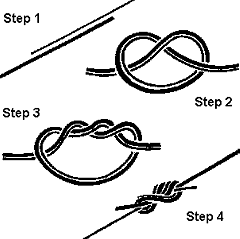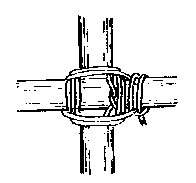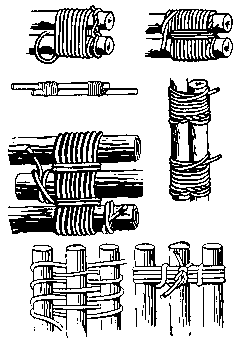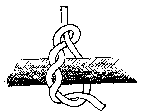Scout It Out
Rope Work
|
Scout It Out |
|
|
Rope Work |
| | Bends | Lashings | Hitches | Stopper Knots | Rescue Knots | Shortenings | Special Knots | List of Useful Rope Work Sites | |
Rope Work introduces the basic knots that all Scouts and Guides should know. Most of the knots featured here are very useful in Pioneering and should be learnt. This Section does not fully teach the exact way of tying but serves as a simple guide for all.
Scout It Out would like to extend its gratitude to all the sites where the following information had been gathered.
Last of all, If you think you have a particular knot in mind and wish to have it featured in Rope Work, simply send a soft copy of the Knot, together with its explanation, to the Webmaster.
Bends (back to top)
Bends are used to join the ends of 2 lengths of rope to form one longer piece. Ideally, to ensure that the knot is secure, the 2 ropes that are joined should be of the same kind and have the same diameter. However, sheet bend is secure even when it is used to join ropes of different diameters.
 |
Reef Knot |
Used to join the two ends of the same rope. |
 |
Sheet Bend |
The Sheet Bend is a knot that you use to tie two ropes together. Good both for thick and thin ropes. |
 |
Fisherman's Knot | For stiff ropes and cords use the Fisherman's Knot. Easy to make, difficult to untie, so don't use it on a good rope, especially if there is a lot of strain on it. |
 |
Surgeon's Knot | This knot has a good grip, twisting as it is drawn up and the diagonal is wrapped around it. It is less bulky and flatter than some of the other knots used by surgeons. |
|
|
Carrick Bend | An excellent knot, probably the nearest to the perfect bend. It is symmetrical, easy to tie, will not slip nor ham, is very strong and is easily untied. Its particular use is as a bend for hawsers and cables. It can be used in two forms, drawn up or open and seized and it should always be tied so that the two ends are diagonally opposite. |
Lashings (back to top)
Lashings binds timbers together with ropes. it is important to use ropes of correct thickness and length.
 |
Square Lashing | The standard lashing used to fasten two spars or poles together, not necessarily at right angles, where there is no tendency for them to spring apart. |
 |
Diagonal Lashing | Used when two crossing spars tend to spring apart. Commonly used for the centre lashing on the diagonal braces of a trestle. |

|
Shear Lashing
|
A lashing used to produce Shear Legs or, alternatively a lashing to secure poles or spars end to end. |
| Figure of 8 Lashing
or Tripod Lashing |
This is used to create a tripod with three spars. We start by first placing the three spars side up side ends to ends butts to butts. Start with a clove hitch on one of the outside spars and weave the rope around the spars in a figure of eight motion. There should be eight bindings side by side before you should apply 3 rounds of frappings between each spar. Finish the lashing with a clove hitch on the opposite outside spar. The three spars should then be lifted upright before the legs are spread. This lashing unlike other must not be too tight or else it will not be possible to spread the legs correctly.
|
Hitches (back to top)
Hitches are knots that are used to secure a rope to a post, hook, ring spar or rail or to another rope that plays no part in the actual tying. Hitches do not keep their shape on their own. they are able to withstand parallel strains as they are often used by sailors for mooring, lashing and fastening.
 |
Timber Hitch | One of the simplest yet most effective of hitches. Used on spars, bales, etc., for commencing a diagonal lashing, and with extra half hitches added, for towing or dragging, etc. |
 |
Round Turn and 2 Half Hitches | This knot is used to make fast a rope to an anchorage. It can be tied while the standing part is under strain. This is a good knot to attach your rope to an anchor for a flying fox or a bridge. |
 |
Rolling Hitch | This useful knot is basically a clove hitch with the first round repeated. It is used by both mariners and mountaineers and is the most effective way of securing a small rope to a large line that is under strain. As long as the smaller rope is perpendicular to the larger, the knot will slide easily along; once tension is exerted on the standing part and working end of the smaller rope, the knot locks in position. |
 |
Clove Hitch | A knot that is easy to make. Usable when you want to moor a boat. Do not use to tie something to a square post as it can easily come off. |
Stopper Knots (back to top)
This group of knots is most often used to prevent the end of a rope from slipping through an eye or a hole. Stopper knots can also be used to bind the end of a line so that it will not unravel and they serve decorative purposes as well.
|
|
Figure of 8 Knot | Sometimes called the Flemish Knot. A single strand Stopper Knot, usually when only a temporary stopper is required or when using small stuff. | |
|
|
|
Overhand Knot or Thumb Knot |
Also called the Simple Knot, Common Knot, Thumb Knot, etc. It is the simplest knot form, secure but weakening the rope considerably and should only be used in small stuff. The Figure-of-Eight Knot is to be preferred. |
Rescue Knots (back to top)
|
|
Bowline | The most useful and one of the simplest ways of putting a fixed loop in the end of a rope. It is easy to tie and untie, it never slips nor jams and has a high breaking strength. |
|
|
Highwayman's Hitch | A most useful Draw Hitch for securing a horse, a boat, etc. or in self rescue work. The knot will take any amount of strain on the standing part but spills the moment the end is pulled. Legend has it that Dick Turpin used this knot on his nefarious errands: if in a hurry to escape, he just had to leap on his horse, Black Bess, at the same time snatching the end, when he was away. |
|
|
Fireman's Chair | A double loop knot used for lowering an injured person from a height. It is tied in the bight, one end secured aloft and the other end used to control the direction of lowering. |
Shortenings (back to top)
These Knots are used to shorten long lines. A shortened rope is always more secure than 2 cut lengths joined together with another knot. In any case, a longer rope may be needed at a later date, and a rope shortened by means of a knot can always be lengthened again, Shortenings can also be used to take up weakened or damaged lengths of line so that they are not subjected to any strain.
|
|
Sheep Shank | A knot tied in the bight for shortening a rope or taking up the slack, without cutting it. It can also be used to protect a weak, damaged or frayed section of the rope. |
Special Knots (back to top)
|
|
Japanese Knot | This is an alternative to the square lashing that is suitable for use in light constructions. |
|
|
Simple whipping | When a rope 'whips' in the wind the end will quickly unravel and fray. Protection can be given by a knot or a Back Splice but the best and most used method is to use a Whipping. |
|
|
Crown | This is knot that is tied in the end of a rope with the unlaid strands. It is seldom, if ever, used on its own but as a constituent part of a multiple knot. It is also used to commence a Back Splice. The Crown Knot is the exact opposite of the Wall Knot. |
|
|
Back Splice | A simple and effective method of finishing the end of a rope in which a Crown Knot is made with the strands at the end which are then spliced back into the rope. It is clumsy compared with Whipping but useful in an emergency or if it is desirous to know by feel when the end of the rope has been reached. |
List of Useful Rope Work Sites (back to top)
| Knots on the Web | http://www.earlham.edu/~peters/knotlink.htm |
| Rescue 70 - Rope Rescue | http://www.rescue70.org/roperes.htm#Knots |
| Australian Scouting Resource - Index of Knots and Lashings | http://www.scouts.asn.au/knot_idx.html |
| Ropers Knots Page | http://www.realknots.com/ |
| The Knotting Dictionary of Kännet | http://www.korpegard.nu/knot/ |
|
|Home
| Guest Book | Links | About Me | |